12 Nov 2020
Tackling obesity and related laminitis in equine patients
A meeting of academics and practitioners with an interest in equine obesity and obesity-related laminitis was convened for <em>Vet Times Equine</em> (sponsored by Bova UK) on 14 January 2020. Published evidence was reviewed and opinions were shared to provide the following summary for veterinary surgeons managing horses with obesity.

Horses live in an obesogenic environment, grazing better-quality pastures than evolution intended, being provided with additional feed and being protected from cold weather. Horses are still managed in a manner developed for horses kept for transport or competition; management systems that are inappropriate if they perform little, or no, exercise. Fundamental changes are required if horses are simply being kept as pets.
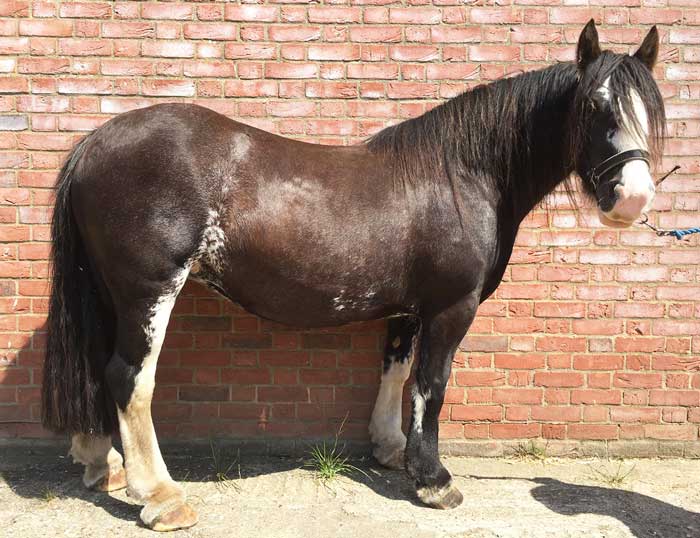
In modern management systems, the natural circannual rhythm of increasing bodyweight (with a peak in October and decreasing bodyweight through winter3) is lost as owners strive for their horses to look their “best” year-round.
The perception of “best” has morphed over time, from horses that are well muscled for work or sport to horses that are well covered in fat.
Many owners do not appreciate the difference between muscling and fat deposition, and the trend toward promoting increased fat deposition has been re-enforced by rewarding obesity in the show and dressage arenas, and by the frequent depiction of obese horses as role models on feed company websites, in the equestrian press and elsewhere.
Obesity is often trivialised – obese animals are often depicted in cartoons; we use endearing terms such as “cuddly”, “tubby” or “podgy”; and no social stigma is associated with keeping an obese animal. By contrast, the sight of a thin or emaciated horse evokes horror and accusations of cruelty.
Assessing and monitoring obesity
Obesity is defined as adiposity to a level that health may be affected, and may be generalised or regional. As such, obesity represents a pathologic state, yet much debate has been had as to whether obesity should be considered a disease per se. In horses, a number of health problems have been associated with excess adiposity.
Obesity has been demonstrated to have a number of negative consequences on health1:
- laminitis
- increased risk of hyperlipaemia
- impaired thermoregulation
- decreased fertility
- inflammageing
- osteochondrosis dissecans
- behavioural disorders
- increased blood pressure
- orthopaedic disease through increased loading
- preputial and mammary oedema and dermatitis
- ventral oedema
- colic as a result of pedunculated mesenteric lipomas
- inappropriate lactation
- reduced growth rates in foals of obese mares
- respiratory compromise and equine asthma
- pharyngeal collapse
Obesity is best assessed by necropsy or by performing in vivo assessment with the administration of deuterium oxide. In practice, obesity is determined by assessing body condition, with ultrasonographic assessment and measurement of biochemical markers in blood also helpful. Body condition can be assessed on a 0-54 or 1-9 scale5. The latter is more robust, but less popular for owners. Either scale is acceptable, provided the denominator is stated.
Ultrasonographic measurements have limitations, but the assessment of retroperitoneal fat by ultrasonographic examination of the ventral midline can be useful in demonstrating horses that are thin on the outside, but fat on the inside (so-called TOFIs)1. Serum insulin and adiponectin are independent risk factors for laminitis, so measurement of both can be useful in persuading owners their horse has metabolic disease and would benefit from a programme of weight loss.
Adiponectin is not recommended as a monitoring tool, as levels are slow to change and lag behind clinical improvements. Measurements of insulin concentration at baseline or after a carbohydrate challenge are useful in assessing laminitis risk and in monitoring improvement in insulin sensitivity in response to weight loss. Fasting prior to insulin sensitivity testing is no longer considered necessary, although it does result in more repeatable results. It is important the same conditions are replicated each time testing is performed when monitoring.
Baseline insulin is a less sensitive marker of insulin dysregulation than insulin following carbohydrate challenge. The oral glucose test, oral sugar (high or low-dose Karo) test, combined glucose insulin test and insulin tolerance test have advantages and disadvantages, and investigate different aspects of insulin dysregulation.
For convenience in practice, the high-dose oral sugar (Karo) test6 is the authors’ preferred option. A bolus of 0.45ml/kg bodyweight Karo light corn syrup is administered orally by syringe, and serum insulin concentration is measured 60 to 90 minutes later. Testing should not be performed when horses have acute, painful laminitis, as stress may result in insulin resistance and falsely increase the result.
While assessment of body condition score is helpful in assessing obesity, it is a non-linear scale and is, therefore, less helpful for monitoring – particularly in very obese animals – with marked weight loss required before the score will change. Measurement of weight – preferably on a weighbridge or, alternatively, with a validated weigh tape – is the most useful indicator of progress.
Some morphometric measurements – such as heart girth (Figure 2), belly girth (Figure 3) and rump width (Figure 4) – are also helpful. Cresty neck score is less reliable, as the crest contains a large amount of fibrous tissue that will remain, even with marked loss of adipose tissue. It is important to find markers that provide owners with gratification, and heart and belly girth are, therefore, the most suitable.
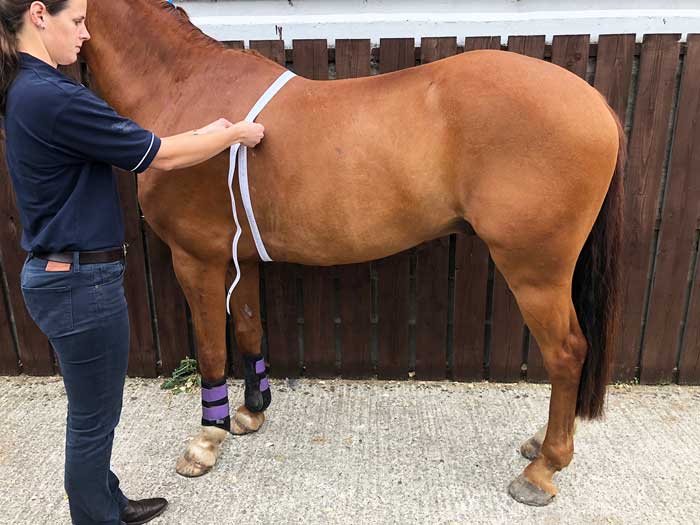
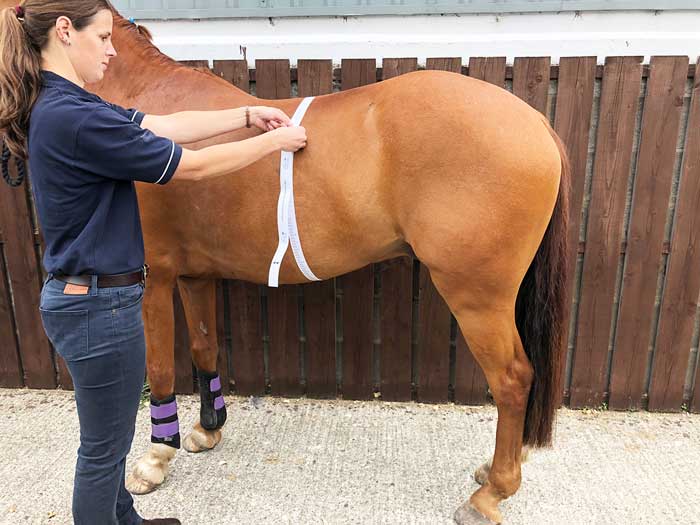
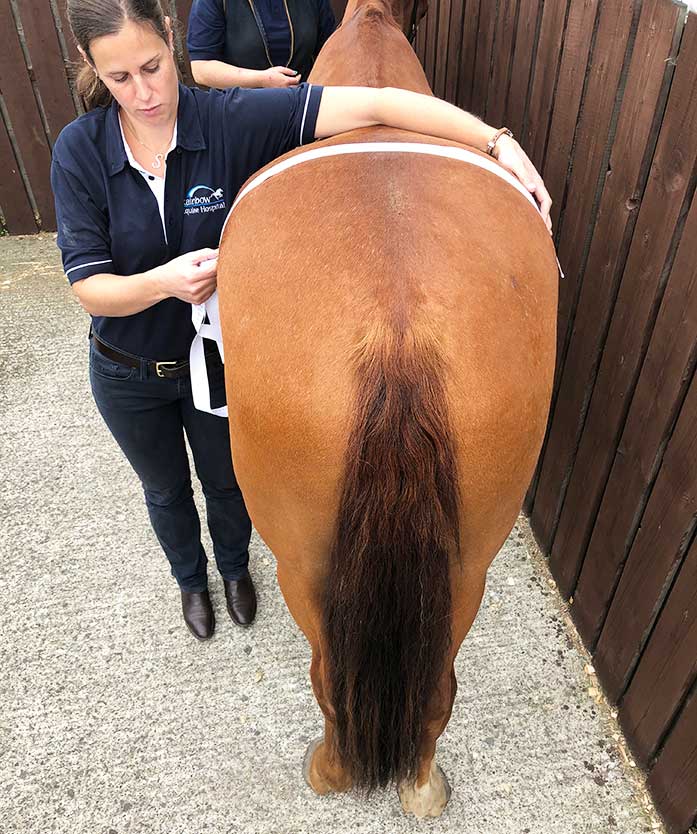
Feeding for weight loss
Owners invariably perceive that horses require far more feed than they do. The upper end of what is typically advised (say 2.5% of bodyweight in dry matter [DM]) will be excessive for native types. Cobs and native ponies are unlikely to require more than 2% bodyweight DM, even if they are exercising regularly.
The risk of overfeeding is compounded by owners’ tendency to markedly underestimate bodyweight; therefore, regular measurement of weight on a scale or a reliable estimate with a weigh tape is important. It is essential, when formulating any weight loss programme, that the contribution from grazing is considered, as this is frequently ignored or incorrectly assumed to be negligible.
Advice on feeding needs to be simple and specific so owners are able to implement the changes in their daily practice. For most owners, compliance will be improved if a specific “recipe” is provided that dictates exactly what quantity of exactly what feed (that is, the trade name) is required.
Providing general advice and telling owners that they need to feed 1.5% bodyweight DM of a feed with less than 10% sugar is unlikely to result in good compliance, because it may be hard for them to put these figures into practice. Vets should be dispensing weight tapes and luggage scales alongside their advice (Figure 5); both can be sourced very cheaply on the internet and can even be branded.
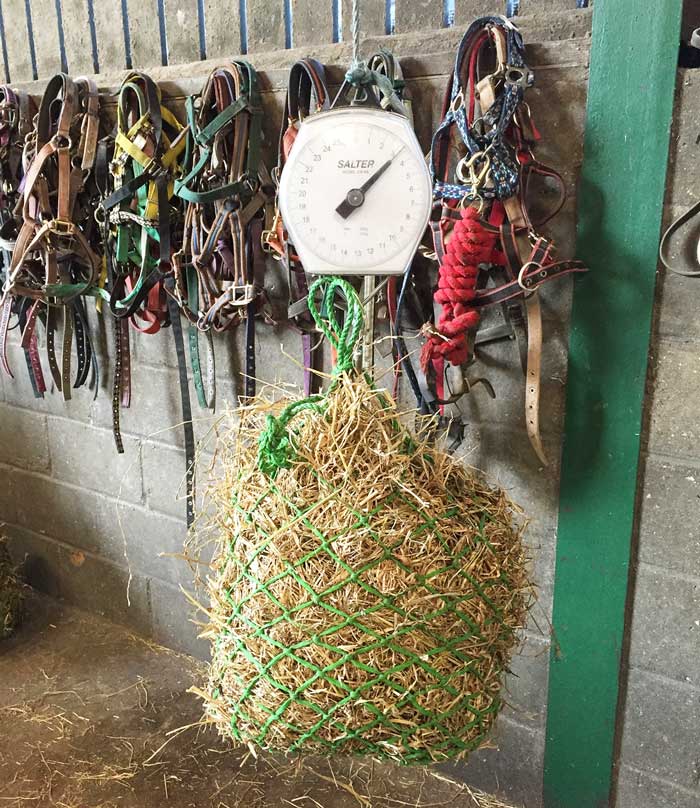
Weigh tapes that provide a weight of food on the tape, alongside the bodyweight of the horse, can be helpful. However, they are likely to provide a suitable weight for maintenance (that is, 2% bodyweight) and so will not be suitable for horses on a weight loss programme – and may even be excessive for maintenance in native types.
Specific advice should also be given to overcome common problems or concerns from becoming barriers to reducing calorie intake. Confusion often happens around DM percentage. While the risk is considered low, particular care needs to be taken with obese ponies and donkeys. In these animals, starting at 2% bodyweight DM and reducing over time has been recommended. Most hays are in excess of 90% DM, so actually assuming measured weight equates to DM weight is permissible if hay is being fed. This is not true of haylage, where the water content is greater and more variable.
Information on feed packaging is often overly long and complicated, and confuses horse owners, as well as veterinary surgeons. A need exists for standardised reporting of nutritional composition, and the use of infographics easy for horse owners to understand would be welcomed. Some commercial feeds and treats do not disclose their sugar and starch content. The use of a single scoop for different feeds can result in overfeeding, as they measure volume rather than weight, with the weights of feeds varying considerably. Scoops need to be calibrated for each feed.
If practitioners are working out the total amount of DM or feed the horse needs, they should clarify the total amount should be weighed out for the day, before being subsequently split into separate portions. Creating and weighing individual portions has been seen to lead to a tendency to feed at the top end of, or even slightly over, the recommended weight each time. Weighing once reduces the percentage error (Figure 6). To provide a reliable estimate of forage requirements, forage analysis would ideally be performed by a reputable method (an example). Depending on how and when it is cut and baled, the non-structural carbohydrate (NSC) value of hay may vary from below 10% (considered optimal) to around 30%, which would equate to some cereal-based feeds.

If owners are soaking hay to reduce its sugar content (which is recommended if NSC is greater than 10%) then it is helpful to perform forage analysis after soaking, as the reduction in NSC concentration that occurs with soaking is highly variable. Steaming hay does not reduce NSC content.
Feeding haylage to horses on weight loss programmes is controversial, and generally should be avoided as haylage typically has a higher NSC content and is more palatable, so intakes may be higher. However, some haylage can have a low NSC content and, if fed in restricted quantities, may be suitable.
Haylage also has a higher (but more variable) water content, which can mitigate, in part, for the higher NSC concentration.
Haylage should not be fed unless it has been analysed. Barley straw can be fed to maintain appropriate levels of fibre and total intake, while reducing calorie intake. A recent study demonstrated that horses fed a 50:50 hay:straw diet lost weight, while those fed hay did not (Kirton and Morgan, unpublished data). Barley straw has an NSC content of around 3%, but is lower in calcium and protein than hay.
Feeding straw has been associated with gastric disease; however, in the authors’ opinion, this risk is low and outweighed by the potential benefits. Straw requires more mastication, so dentition should be checked prior to feeding it. In many parts of the world, where hay/haylage is less freely available, straw is the primary supplementary forage for horses. Feeding large-bale straw may be perceived negatively on yards and, if this is a barrier, packaged chopped straw is available from feed merchants. Straw may be dusty and may benefit from rinsing prior to feeding.
Grazing management
In most overweight native breeds, any access to pasture is going to severely frustrate attempts at weight loss. It is, therefore, best to remove obese horses with a risk of laminitis from pasture. When obesity-prone horses are turned out, management of grazing is important to prevent weight gain.
Most hot-blooded or warm-blooded horses in competition exercise can be managed from pasture without supplementary feeding, highlighting the excessive calories that will be provided to non-exercising natives given unlimited access to pasture. Where possible, horses of similar body condition should be managed together.
Track systems are a relatively recent development in managing access to grazing. These involve creating a track around the perimeter of a field, with resources (such as food and water) placed at opposite ends. Some provide tracks with grass-free surfaces, while others simply create a track around a grass field. Anecdotal reports suggest some track systems are effective in managing weight, but evidence is lacking.
The amount of voluntary exercise horses take may vary from horse to horse and track to track. A “cross-shaped” track has been reported by some to allow more flexibility around fixed corner posts; however, as fences are drawn in toward the centre, the area of grazing horses have access to is likely to become excessive.
Problems with herd dynamics can occur in track systems, as dominant animals may guard walkways and feeders, and bullying may result. The amount of supplementary feed placed in track systems is frequently excessive. When supplementary feed is required in grazing systems, the use of straw can be considered, and trickle nets are available for ring feeders to prolong access to additional feed (Figure 7; www.tricklenet.co.uk). When estimating the quantity of additional feed to be fed, it should be remembered horses will continue to graze pasture, however bare it appears.
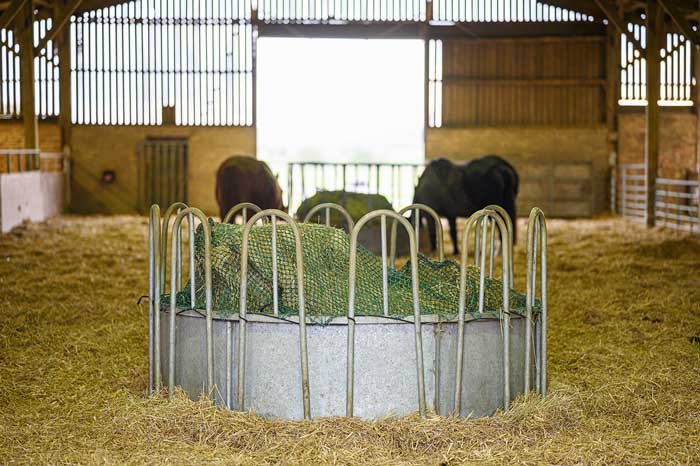
Equicentral systems are an alternative method of managing grazing, aiming to provide a grass-free area and alternating access to different paddocks. Again, formal evidence is lacking.
Strip grazing is another popular means of limiting access to grazing. However, strip grazing can amount to intermittent ad-lib feeding if grass on the far side of the fence is not managed. This not only frustrates attempts at weight loss, but results in peaks in insulin concentration that increases laminitis risk. New strips of grazing are often long, and as fences move the area of grazing becomes larger, and frequently excessive (Figure 8).
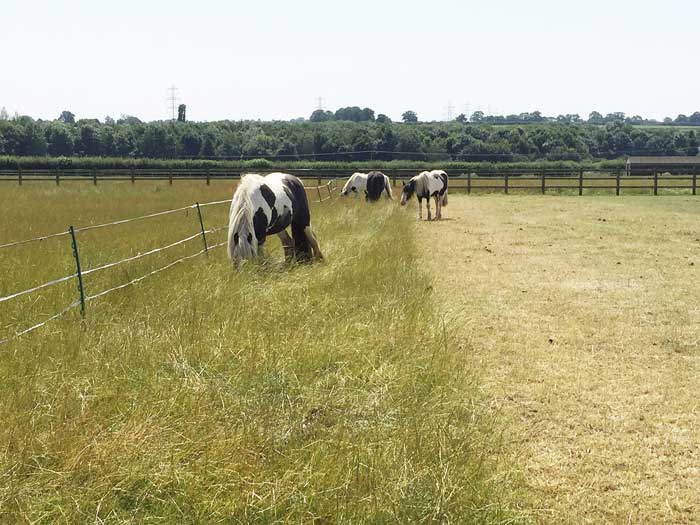
on both sides of the fence.
The area of pasture required for maintenance is far smaller than most owners expect – particularly for ponies. Bare pasture often raises a concern more grazing is required. However, pasture is bare because it is being continually eaten. Highlighting the quantity of grass on adjacent pasture not being grazed, and the amount of faeces that is continuing to be passed, may demonstrate bare pasture is providing adequate feed intake. Measurement of bodyweight provides the best indicator of whether feed intake is sufficient.
Pasture analysis can be performed, but the nutritional value of grass varies markedly with weather and season, so analysis at one point in time has limited value. By contrast, analysis of forage to be fed through the winter is very helpful – assuming the same batch is to be fed for a period of time. Restricting access to grazing in the summer is very challenging, and offering turnout on alternate surfaces is often a better solution that might also help preserve grazing for the winter, when it is in shorter supply and presents less of a risk for laminitis. Co-grazing with sheep is an excellent way of reducing the quantity of pasture available through the summer months.
The duration of turnout can be limited to restrict access to grazing. However, this is often ineffective, as large quantities of forage can be ingested in a very short period of time. As a guide, ponies can ingest their entire daily ration within three hours, and all horses will adapt to shorter periods of grazing by eating faster7. Turnout at night, when grass is not photosynthesising, is perceived to be preferable. However, at the end of the day, concentrations of sugar may be at their highest and will drop through the night, to such an extent turnout early in the morning until noon may, in fact, be preferable.
Grazing muzzles work well for some horses, but are not tolerated by others, meaning welfare may be compromised. Grass needs to be an appropriate length to enter the muzzle for horses to be able to eat it. Muzzles inhibit normal behaviour, such as communication and grooming. Advice on using grazing muzzles is available from the National Equine Welfare Council. Grazing bare paddocks may be resisted on the basis stems are higher in sugar than leafy grass. Although fast-growing grass may have a lower sugar concentration than stemmy, stressed grass, this is likely to be more than counteracted by the increase in volume of available grass.
Sand colic can become a concern if horses are grazing bare pasture, and on sandy soils it may be necessary to remove horses from pasture and turn them out on other surfaces, such as woodchip. On sandy soil where supplementary forage is being provided, placing feeders on rubber mats or areas of hard-standing is preferable. With woodchip surfaces and straw feeding, a small risk of intestinal impaction exists, so faecal output should be monitored and a transition to straw feeding should be made gradually.
Owners that have kept horses stabled for the majority of the winter will be anxious to turn them out in the spring as grass growth increases. Unfortunately, this represents the time when the risk of laminitis is greatest and limiting access to grazing is most important. The risk will be reduced if horses have lost weight over the winter, and it is important owners plan ahead for the spring and (where available) use stabling over the winter months as a perfect opportunity to limit feed intake and promote weight loss.
In spring, owners should be encouraged to turnout on paddocks that have been heavily grazed and poached through the winter, rather than on lush fresh pasture.
Rugging
Studies have demonstrated that in all but the most inclement weather, most horses of native breeding (cold-blooded breeds, which are prone to obesity) would prefer to remain out at pasture than be stabled. Horses are able to thermoregulate between 5°C and 25°C – and, therefore, require no additional measures to control their body temperature (for example, rugs) between these temperatures.
Horses acclimatised to lower temperatures are able to thermoregulate at temperatures as low as -10°C to -15°C8. Geriatric horses may be less able to thermoregulate at lower temperatures. Quilted rugs may increase surface body temperatures by as much as 16°C, with lightweight sheets raising temperatures by around 11°C9.
Above 10°C, horses prefer not to be rugged except in extreme wet or windy weather conditions10,11; if the weather is neither wet nor windy, rugs are only required below 5°C, and acclimatised horses may only require rugs below temperatures as low as -10°C.
Unnecessary rugging, therefore, represents a welfare concern in causing horses to become too hot in warmer weather and unable to thermoregulate; depriving horses of rugs is less likely to impact on their welfare. Breeds prone to obesity will be the most resilient to cold weather. Provision of a field shelter providing protection from wind and rain is a far better solution to cold weather than rugging.
Enrichment
Implementing weight loss programmes can have an impact on horses’ ability to express normal behaviour – and, therefore, it should be considered as compromising welfare. Many horses have to be removed from pasture and from their social groups for weight loss to be achieved. This can present a major barrier to achieving weight loss.
However, the potential welfare impact of obesity-related disease (and particularly laminitis) is far greater than the welfare impact of temporarily restricting normal behaviour. Owners should be persuaded that the sooner they can achieve the necessary weight loss, the sooner the horse can return to a more normal management system.
Further advice for owners on enriching the environment in horses with weight loss is available in the equine weight management guide form the University of Liverpool and The Horse Trust.
Exercise
As horses have transitioned from being beasts of burden to domestic pets, the amount of exercise they typically perform has declined. Many horses do not exercise beyond ambulating to find food or playing with cohorts. Exercise burns calories, increases insulin sensitivity and provides a means of enrichment for horses that are being managed to promote weight loss. The terms work and exercise are frequently used interchangeably, yet their connotations are very different. Few horses in the UK perform a job of “work”, and the term has a negative connotation so should be avoided in favour of the term exercise, which has positive connotations. Making exercise a social event can be helpful; few overweight horses would have to look far to find an overweight companion they could exercise with.
The amount of exercise that can be performed will be influenced by prior bouts of laminitis. Exercise alone will not result in weight loss, but it can be a very helpful adjunct to dietary management. When determining exercise programmes, risk of sub-clinical laminitis should be considered, as there may be as many undiagnosed cases of laminitis with radiographic changes as there are clinical cases.
Recommendations around desired exercise levels are largely opinion-based, yet to achieve compliance any exercise programme needs to be both specific and realistic. In a recent consensus statement12, the following exercise recommendations were made:
- Horses without laminitis: heart rate should be above 130bpm for at least 30 minutes, five or more times a week; however, this may not be possible from day one, as it will depend on the initial fitness of the patient.
- Horses with previous history of laminitis: low-intensity exercise on a soft area (heart rate of 110bpm to 150bpm), for 30 minutes, three days per week, while always monitoring for signs of lameness.
A protocol for 50 minutes of exercise has previously been proposed, with a 10-minute warm-up at walk, and then alternating trot sets and walk breaks of 5 minutes each, finishing with a 5-minute cool-down13. It was suggested this protocol be performed five days per week. As horses become fitter, the trot sets can be replaced with canter.
Pharmaceuticals
Pharmaceutical treatment is no substitute for appropriate management of obese horses. However, pharmaceuticals may be considered in some circumstances:
- Horses with weight loss resistance where weight has not reduced, despite appropriate dietary management.
- Horses considered to be at a high risk of laminitis, where more rapid weight loss is desirable.
- Horses that cannot exercise as a result of laminitis or other orthopaedic disease.
- Horses whose welfare is considered to be unacceptably compromised by elimination of grazing.
- Horses at risk of laminitis where immediate reduction of insulinaemic responses is desired beyond what can be achieved with dietary restriction.
Levothyroxine is the most appropriate pharmacologic treatment for promoting weight loss and has also been demonstrated to improve insulin sensitivity14,15. Levothyroxine is used widely in the US for the treatment of obesity and equine metabolic syndrome (EMS), and has even been suggested to be the most overused drug in equine practice in the United States16, as it is used indiscriminately without sufficient consideration. Levothyroxine should not be used as an alternative to changes in management, but it is a useful adjunct when used appropriately.
Recent data has demonstrated levothyroxine is safe, even when used at 10 times the dose used clinically17. Levothyroxine would be the most appropriate solution in the first four of the aforementioned bulleted scenarios. Short-term use of levothyroxine helps in reducing bodyweight more quickly, and may, therefore, allow more rapid reintroduction to more normal management and access to grazing. It may facilitate a return to exercise in very overweight animals. The approach may improve owner compliance and may reduce the risk of laminitis in animals that might otherwise not lose weight as they need to.
It is essential some compliance exists with dietary recommendations when using levothyroxine, or weight loss is unlikely to result due to polyphagia. Levothyroxine has traditionally been used at 0.1mg/kg by mouth once a day for a period of three to six months or until the target for weight loss is achieved. Treatment is expensive, and treatment of that duration is frequently cost prohibitive in non-insured cases.
A strategy used more of late is to administer levothyroxine for the first month of a weight loss programme, and rely thereafter on management alone. Seeing the benefit of the first month’s interventions may help encourage owners and promote compliance in the longer term. Levothyroxine has also been used in treating acute laminitis in horses with EMS. While levothyroxine has been demonstrated to improve the insulin dysregulation that will be responsible for the laminitis, no evidence is available to show levothyroxine results in a better outcome from the laminitis. When treatment with levothyroxine is to be discontinued, it is recommended the dose is halved for two weeks, then halved again for a further two weeks before ceasing treatment.
Metformin has been used widely to reduce the risk of laminitis (the fifth of the aforementioned bullets), but it is not an appropriate treatment for obesity per se. The authors question whether metformin has sufficient clinical benefit to merit its use, and if it is used, it should be a short-term solution around periods of laminitis risk.
It is preferable to prevent the periods of high risk of laminitis by ensuring weight loss and avoid exposure to feeding/grazing that is likely to result in hyperinsulinaemia. If metformin is used, it is important to define an end point for treatment, as a tendency exists for it to be used indefinitely in horses with chronic obesity or recurrent laminitis. What is actually required is a more disciplined and effective programme of weight loss. Pharmaceuticals are only ever a short-term adjunct to management changes that will need to be sustained after pharmaceuticals are discontinued.
Implementing change
Continued compliance with veterinary recommendations is frequently reported to be poor. Owners are unlikely to respond to being rebuked, but require positive messages, and regular support and re-enforcement, in making changes for their horse’s health. Managing horses tends to be a matter of routine, and it is important the management routine can be adapted so it not only incorporates changes likely to result in weight loss, but it is also manageable for the owner to implement over time.
Fundamental change to the manner horses are kept in may be required to facilitate changes in the daily and weekly routines that work for owners.
Many owners are heavily restricted in horses’ management by the requirements of their yards. Owners are also frequently concerned about making management changes that will negatively impact a horse’s psychological well-being. As a result, working with owners to determine the weight management strategies that will work effectively for them, on their yard and with their horse, is likely to result in owners being able to make prolonged change.
The University of Liverpool’s weight management guide can be used to have detailed discussions with owners and plan weight management strategies that will work for them. Further, investment by vets to act as a support team (possibly in collaboration with the farrier) by checking in with owners about their weight management progress, could help owners to feel supported and empowered.
Targets are helpful and provide a sense of purpose, so it is useful to provide charts to monitor morphometric characteristics and bodyweight.
Targets for exercise based on working towards the owner’s aspirations (for example, to get the horse fit enough to enter a sponsored ride) are also a powerful motivator. Using apps, social media groups or devices in horses that allow exercise targets to be set and progress to be tracked can be helpful. One example is to encourage owners to join Your Horse’s #Hack1000Miles campaign, which encourages owners to track their hacking over a year and share on social media. They gain rewards as they build mileage.
In developing plans for weight loss, it is important goals are achievable and interim targets are set. It is better to set a short-term goal than fixate on the ultimate target. Introducing weekly weigh tape measuring and monthly photographing to the owner’s routine can be helpful, and if the results are communicated to the vet, it allows for an opportunity for positive re-enforcement or modification of the programme, if necessary.
Loss of 0.5% to 1% bodyweight per week should be achievable; however, some consideration may need to be given to the season if horses remain at grazing. In winter, when dietary control can be total, and horses have evolved to lose weight, it should be possible to achieve more marked and consistent weight loss.
Additional resources
Compliance with veterinary recommendations limits the effectiveness of weight loss programmes. The internet is awash with advice that is variable in quality and often provided by those with a commercial bias – particularly feed manufacturers. Veterinary surgeons should remain cognisant of the fact advice must remain simple, and underlying knowledge should not be assumed.
Resources recommended for horse owners with obese horses are available on the BEVA website, where a weight tracking spreadsheet can also be found.
References
- Rendle D et al (2018). Equine obesity: current perspectives, UK-Vet Equine 2(Supp 5): 1–19.
- Menzies-Gow N et al (2017). Prospective cohort study evaluating risk factors for the development of pasture-associated laminitis in the United Kingdom, Equine Vet J 49(3): 300-306.
- Giles S et al (2012). Seasonal fluctuation and unexplained variation: cross sectional studies of prevalence and risk factors for equine obesity in North Somerset, England: 1-2.
- Carroll C and Huntington P (1988). Body condition scoring and weight estimation of horses, Equine Vet J 20(1): 41-45.
- Kohnke J (1992). Feeding and Nutrition – The Making of a Champion, Birubi Pacific, Australia: 163-166.
- Jocelyn N et al (2018). Effect of varying the dose of corn syrup on the insulin and glucose response to the oral sugar test, Equine Vet J 50(6): 836-841.
- Ince J et al (2011). Changes in proportions of dry matter intakes by ponies with access to pasture and haylage for 3 and 20 hours per day respectively, for six weeks, J Equine Vet Sci 31(5): 283.
- McBride G et al (1985). Metabolic rate and plasma thyroid hormone concentrations of mature horses in response to changes in ambient temperature, Can J Anim Sci 65: 375-382.
- Hammer C and Gunkelman M (2019). Effect of different blanket weights on surface temperature of horses in cold climates, J Equine Vet Sci 85: 102848.
- Mejdell CM et al (2019). The effect of weather conditions on the preference in horses for wearing blankets, Appl Anim Behav Sci 212: 52–57.
- Mejdell CM et al (2016). Horses can learn to use symbols to communicate their preferences, Appl Anim Behav Sci 184: 66–73.
- Durham AE et al (2019). ECEIM consensus statement on equine metabolic syndrome, J Vet Intern Med 33(2): 335-349.
- Moore JL et al (2019). Effects of diet versus exercise on morphometric measurements, blood hormone concentrations, and oral sugar test response in obese horses, J Equine Vet Sci 78: 38-45.
- Frank N et al (2008). Effects of long-term oral administration of levothyroxine sodium on glucose dynamics in healthy adult horses, Am J Vet Res 69(1): 76-81.
- Frank N et al (2005). Effects of oral administration of levothyroxine sodium on concentrations of plasma lipids, concentration and composition of very-low-density lipoproteins, and glucose dynamics in healthy adult mares, Am J Vet Res 66(6): 1,032-1,038.
- McFarlane D (2014). Pharmacological treatment of equine endocrine diseases. In Cole C, Bentz B and Maxwell L (eds), Equine Pharmacology, John Wiley and Sons, Ames: 270-278.
- Bertin FR et al (2019). Effects of high doses of levothyroxine sodium on serum concentrations of triiodothyronine and thyroxine in horses, Am J Vet Res 80(6): 565-571.
